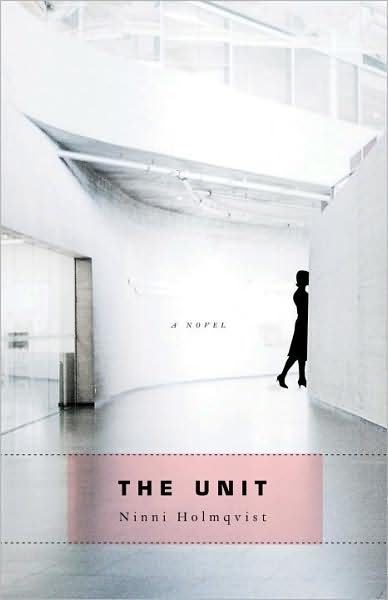The Unit, by Ninni Holmqvist
Aug 5
2009

The Unit, the debut novel by Swedish author Ninni Holmqvist, is neither fish nor fowl nor good Swedish surströmming. It's half dystopian horror story and half mid-life coming-of-age novel, and it might have worked better if the author had settled on one or the other.
Holmqvist's novel is set in a near-future Europe where "dispensable" adults (unmarried, childless, middle-aged, and engaged in nonessential professions) are shipped off to the Unit, a facility that surrounds its residents with luxury and comfort, but requires them to serve as human guinea pigs for the medical industry and donate a series of increasingly vital organs. When lonely, impoverished Dorrit Weger is admitted to the Unit, she finds new friends and an unexpected love—both of which make the impossible choice she is forced to make all the more terrible.
Many of the passages in Holmqvist's novel are gorgeously descriptive, and her heroine's love for her fellow residents is moving, but the undeniable strength of her writing is obscured by the gaping holes in her plot. The major plot twist in this novel is distractingly implausible, and its sci-fi/horror setting raises more questions than it answers. (For one thing, why is there such hot demand for organs? I mean, if every single, childless, under-employed middle-aged person in the U.S. was required to give up several organs, I'm pretty sure the organ waiting lists would be non-existent. And if you eliminate very young recipients, who probably wouldn't have much use for middle-aged organs, you're talking about an even smaller group.) Holmqvist's novel was clearly aiming for "thought-provoking", and her delicate, haunting writing style shows promise, but her plot-development skills will require way more work before she starts challenging the status of top-shelf (or even medium-shelf) authors working in the same genre.
Holmqvist's novel is set in a near-future Europe where "dispensable" adults (unmarried, childless, middle-aged, and engaged in nonessential professions) are shipped off to the Unit, a facility that surrounds its residents with luxury and comfort, but requires them to serve as human guinea pigs for the medical industry and donate a series of increasingly vital organs. When lonely, impoverished Dorrit Weger is admitted to the Unit, she finds new friends and an unexpected love—both of which make the impossible choice she is forced to make all the more terrible.
Many of the passages in Holmqvist's novel are gorgeously descriptive, and her heroine's love for her fellow residents is moving, but the undeniable strength of her writing is obscured by the gaping holes in her plot. The major plot twist in this novel is distractingly implausible, and its sci-fi/horror setting raises more questions than it answers. (For one thing, why is there such hot demand for organs? I mean, if every single, childless, under-employed middle-aged person in the U.S. was required to give up several organs, I'm pretty sure the organ waiting lists would be non-existent. And if you eliminate very young recipients, who probably wouldn't have much use for middle-aged organs, you're talking about an even smaller group.) Holmqvist's novel was clearly aiming for "thought-provoking", and her delicate, haunting writing style shows promise, but her plot-development skills will require way more work before she starts challenging the status of top-shelf (or even medium-shelf) authors working in the same genre.
Posted by: Julianka
No new comments are allowed on this post.
Comments
No comments yet. Be the first!